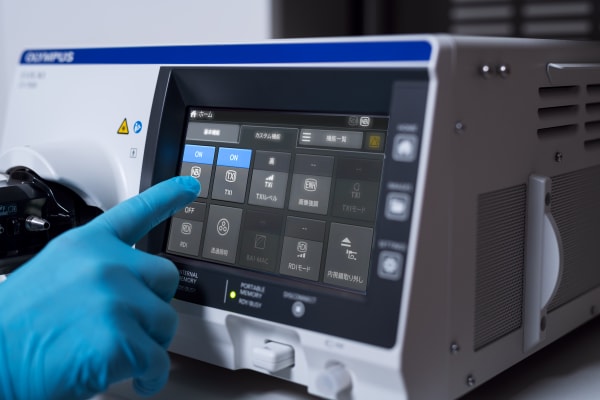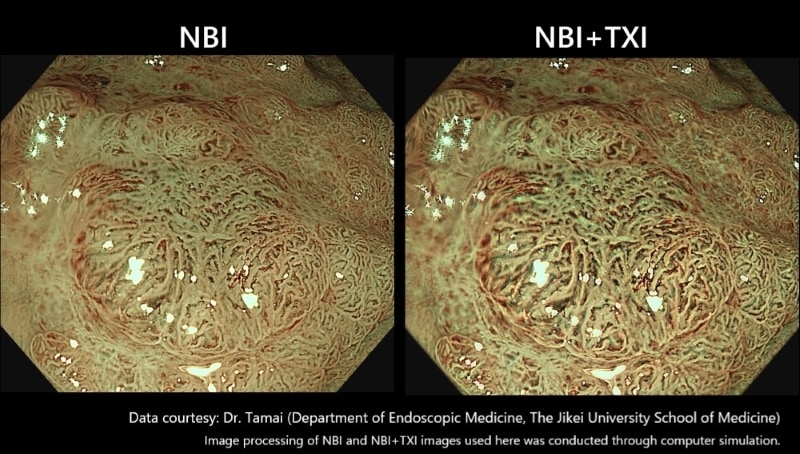Olympus Introduces NBI+TXI™ Observation Mode to the EVIS X1™ Endoscopy System CV-1500 Video System Center
October 29, 2025

CV-1500
TOKYO, October 29, 2025 - Olympus Corporation (Olympus), a global MedTech company committed to making people’s lives healthier, safer and more fulfilling, today announced the launch of the NBI+TXI™ observation mode, which combines Narrow Band Imaging (NBI™ mode) and Texture and Color Enhancement Imaging (TXI™ mode) into a single view. Sales of the EVIS X1™ endoscopy system featuring the NBI+TXI mode will begin in Japan in November 2025, with launches in other regions to follow pending local regulatory approvals.
Since its initial launch in April 2020, the EVIS X1 endoscopy system has supported healthcare professionals with advanced imaging technologies including TXI mode, NBI mode and RDI™ mode (Red Dichromatic Imaging). These proprietary innovations have contributed to more precise observation and treatment of gastrointestinal and respiratory diseases, including cancer.
The NBI+TXI mode further strengthens the EVIS X1 endoscopy system’s diagnostic capabilities by enhancing the brightness correction and contrast information of NBI mode. This enables clearer visualization in darker areas of the image and sharper definition of vascular and mucosal patterns, which can contribute to improved detection and diagnostic accuracy for lesions, including those associated with cancers.
According to 2021 statistics from the Ministry of Health, Labour and Welfare1, colorectal cancer has the highest incidence rate among all types of cancer in Japan, with 154,585 cases, followed by lung cancer (124,531 cases), and stomach cancer (112,881 cases). These cancers also rank among the leading causes of cancer-related deaths, with lung cancer first (75,762 deaths), colorectal cancer second (53,131 deaths), and stomach cancer fourth (38,771 deaths).
NBI mode, first introduced globally in 2006, brought a revolutionary change to endoscopic imaging by improving visibility of features that were previously difficult to detect, making the invisible visible. The CV-1500 incorporates the latest NBI mode, achieving improved brightness compared to the original NBI mode. TXI mode, introduced with the CV-1500, further improves the visibility of lesions through its image enhancement technology when used with conventional light observation. The combination of these two technologies in the CV-1500, the NBI+TXI observation mode is expected to further enhance and optimize the contrast information in NBI mode images, supporting more precise endoscopic examinations and treatments.

Left: NBI mode image Right: NBI+TXI mode image
Supporting Better Mucosal Visibility
TXI mode supports better visibility of potential and extant lesions, such as areas of inflammation, flat or depressed lesions, or even tiny precursor lesions, by enhancing texture, brightness and color to define subtle tissue differences more clearly. With its advanced imaging technology, TXI mode has the potential to reinvent white light in endoscopy. By supporting better visibility of potential and extant lesions, TXI mode may contribute to higher detection rates and improve qualitative diagnosis.
NBI mode is a powerful and proven optical technology creating strong contrast between vessels and surrounding mucosa that allows for a high-confidence optical diagnosis using specific blue and green wavelengths. NBI mode not only supports earlier detection of lesions but also provides a more detailed, higher-contrasted visualization that can improve qualitative diagnosis.
“We know that early detection improves patient care and outcomes.” said Kurt Heine, Senior Vice President and General Manager for Gastroenterology, Olympus. “Olympus is committed to providing the advanced endoscopic imaging physicians need to clearly visualize the GI tract and provide timely diagnoses and treatment. We're excited to expand upon the innovations of our EVIS X1 endoscopy system with this combined imaging mode capability and continue elevating the standard of care."
Physicians attending JDDW, scheduled for October 30–November 1, 2025 at the Kobe Convention Center will have the opportunity to see the combined NBI+TXI imaging mode firsthand.
1 CANCER INCIDENCE OF JAPAN 2021
About Olympus
At Olympus, we are committed to Our Purpose of making people’s lives healthier, safer and more fulfilling. As a global medical technology company, we partner with healthcare professionals to provide innovative solutions and services for early detection, diagnosis and minimally invasive treatment, aiming to improve patient outcomes by elevating the standard of care in targeted disease states. For more than 100 years, Olympus has pursued a goal of contributing to society by producing products designed with the purpose of delivering optimal outcomes for its customers around the world. For more information, visit https://www.olympus-global.com/ and follow our global LinkedIn and X accounts.
Download
* Products or devices presented include future technology which may be pending regional regulatory approval and are not available for sale in all regions.
* The contents in this website including products availability, specifications or prices are the information as of the date of announcement and are subject to change without prior notice.
* Information is intended to be presented to the media, shareholders, investors, and other interested parties. Information about our medical products (including products currently under development) included in this website is not intended for advertising or medical advice.
* Olympus Corporation assumes no responsibility for any damage resulting from the use of this material.
* All company names and product names mentioned in this website are trademarks or registered trademarks of their respective companies. ® and TM marks are not specified in this website. All trademarks and registered trademarks are the property of their respective owners.

